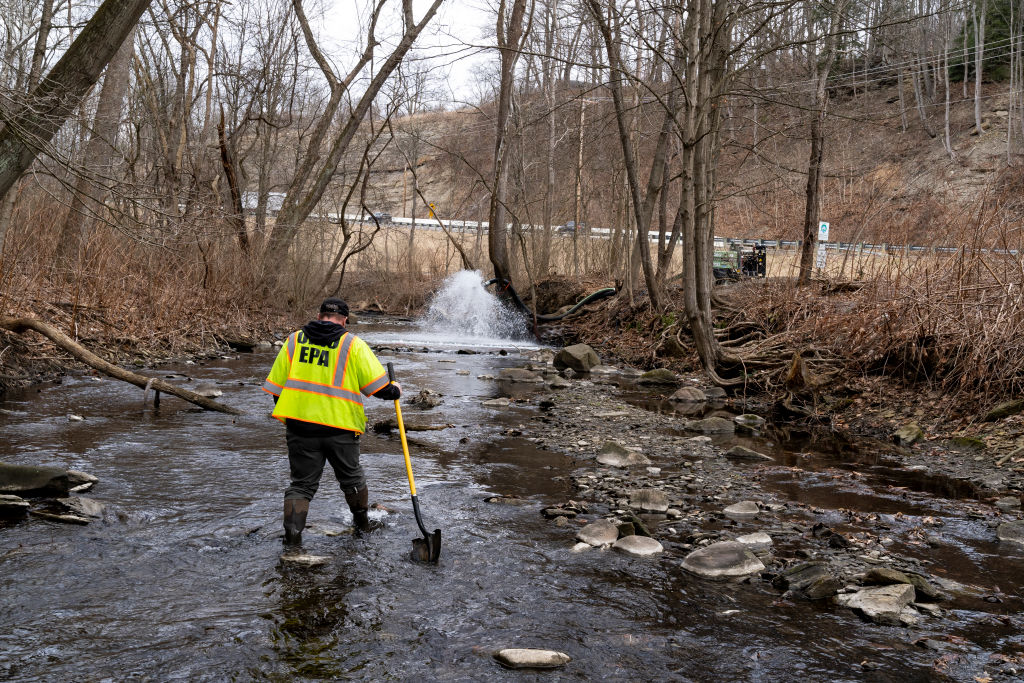Ohio Train Derailment Aftermath: Lingering Toxic Chemicals In Buildings

Table of Contents
Types of Toxic Chemicals and Their Persistence
The Ohio train derailment released a cocktail of hazardous chemicals, including vinyl chloride, butyl acrylate, and ethylene glycol monobutyl ether. Understanding the properties of these chemicals is crucial to comprehending the long-term risks associated with building contamination.
-
Vinyl chloride: This volatile organic compound (VOC) is known for its carcinogenic properties. Its volatility means it can readily evaporate and spread, potentially leaving lingering residues in building materials, particularly porous ones like drywall, insulation, and carpeting. Even after the initial release, vinyl chloride can continue to off-gas, leading to prolonged exposure.
-
Butyl acrylate: This chemical is less volatile than vinyl chloride but readily absorbs into various surfaces, including fabrics, wood, and plastics. This absorption means it can be released slowly over time, leading to chronic exposure. Butyl acrylate is known to cause skin and respiratory irritation.
-
Ethylene glycol monobutyl ether: This chemical also presents a health risk, potentially leading to various issues including irritation and, with prolonged exposure, more serious health problems.
-
The Formation of New Compounds: The interaction of these chemicals with each other and with building materials could also lead to the formation of new, potentially more harmful compounds, adding complexity to the assessment and remediation process. This highlights the difficulty in detecting and remediating these chemicals, especially within the porous nature of many building materials.
Health Risks Associated with Chemical Exposure
Exposure to the chemicals released in the Ohio train derailment carries significant health risks, both short-term and long-term.
-
Short-term effects: These can include respiratory problems (coughing, shortness of breath, burning sensations), eye and skin irritation, headaches, and nausea. These symptoms can be triggered by even relatively low levels of exposure to chemicals like butyl acrylate and ethylene glycol monobutyl ether.
-
Long-term effects: Chronic exposure to vinyl chloride, for instance, significantly increases the risk of various cancers, including liver cancer. Long-term exposure to other chemicals could lead to neurological effects, respiratory illnesses, and reproductive issues. Vulnerable populations, such as children, the elderly, and those with pre-existing health conditions, are at a heightened risk. The impact on the health of the community may extend far beyond the initial emergency response.
Contamination Pathways and Spread
The toxic chemicals released in the derailment entered buildings through various pathways:
-
Air infiltration: Volatile chemicals like vinyl chloride were carried by air currents, infiltrating buildings through gaps in windows, doors, and other openings.
-
Contaminated water: Water sources could have been contaminated, leading to chemical intrusion via plumbing systems or seepage into basements.
-
Physical contact: Direct contact with contaminated soil, debris, or other materials could transfer chemicals to clothing and skin, resulting in exposure.
The potential for wider dissemination extends beyond individual buildings. Airborne contaminants can travel significant distances, potentially impacting a larger geographical area. Soil and water contamination can persist for years, posing a long-term threat to both the local ecosystem and human health through bioaccumulation. The environmental consequences of the derailment remain a critical concern.
Cleanup and Remediation Efforts
Cleaning up the contamination from buildings following the Ohio train derailment presents significant challenges:
-
Detection and removal: Identifying and removing these chemicals requires specialized equipment and expertise. Pinpointing the extent of contamination often necessitates extensive testing and analysis.
-
Remediation techniques: Techniques may include air scrubbing, specialized cleaning solutions, and in some cases, complete demolition and rebuilding. The cost of these procedures can be substantial, adding to the economic burden of the disaster.
-
Long-term monitoring: Even after apparent cleanup, ongoing monitoring is necessary to ensure that residual contaminants do not pose a continued threat. This long-term commitment to assessing and mitigating risks is vital.
Legal and Regulatory Response
The Ohio train derailment has triggered a complex legal and regulatory response:
-
Investigations: Investigations into the cause of the derailment, the adequacy of the initial response, and the extent of the contamination are ongoing.
-
Legal actions: Affected residents and businesses may file lawsuits against the railroad company and other involved parties, seeking compensation for damages, medical expenses, and property losses.
-
Regulatory oversight: Environmental protection agencies are playing a crucial role in overseeing the cleanup efforts and enforcing environmental regulations. The long-term impact of the legal and regulatory response remains to be seen.
Conclusion
The Ohio train derailment's aftermath extends far beyond the initial emergency response. The lingering presence of toxic chemicals in buildings presents a serious and ongoing threat, demanding comprehensive and long-term remediation efforts. Understanding the types of chemicals involved, the associated health risks, and the complexities of cleanup is crucial for protecting public health and the environment. Further investigation and transparent communication are vital to ensuring the safety of affected communities. If you suspect building contamination related to the Ohio train derailment, seek professional assessment and remediation services immediately. Don't delay addressing the potential dangers of lingering toxic chemicals in buildings; your health and the health of your community depend on it.

Featured Posts
-
 At And T Sounds Alarm Extreme Price Hike On V Mware After Broadcom Acquisition
Apr 28, 2025
At And T Sounds Alarm Extreme Price Hike On V Mware After Broadcom Acquisition
Apr 28, 2025 -
 Yankees Vs Royals 2000 A Detailed Account Of The Game
Apr 28, 2025
Yankees Vs Royals 2000 A Detailed Account Of The Game
Apr 28, 2025 -
 Starbucks Union Rejects Companys Proposed Wage Increase
Apr 28, 2025
Starbucks Union Rejects Companys Proposed Wage Increase
Apr 28, 2025 -
 Identifying The Countrys Next Big Business Areas
Apr 28, 2025
Identifying The Countrys Next Big Business Areas
Apr 28, 2025 -
 Open Ai Under Ftc Scrutiny Chat Gpts Future In Question
Apr 28, 2025
Open Ai Under Ftc Scrutiny Chat Gpts Future In Question
Apr 28, 2025
Latest Posts
-
 Frieds Yankee Debut A Success As Offense Explodes Against Pirates
Apr 28, 2025
Frieds Yankee Debut A Success As Offense Explodes Against Pirates
Apr 28, 2025 -
 Yankees Fried Makes Strong Debut In 12 3 Victory Over Pirates
Apr 28, 2025
Yankees Fried Makes Strong Debut In 12 3 Victory Over Pirates
Apr 28, 2025 -
 Max Frieds Yankee Debut Dominant Offense Crushes Pirates 12 3
Apr 28, 2025
Max Frieds Yankee Debut Dominant Offense Crushes Pirates 12 3
Apr 28, 2025 -
 The 2000 Yankees Rally Overcoming The Royals For The Win
Apr 28, 2025
The 2000 Yankees Rally Overcoming The Royals For The Win
Apr 28, 2025 -
 Yankees Vs Royals 2000 A Detailed Account Of The Game
Apr 28, 2025
Yankees Vs Royals 2000 A Detailed Account Of The Game
Apr 28, 2025
